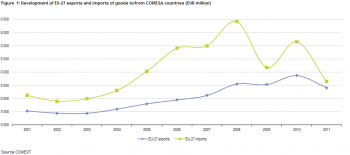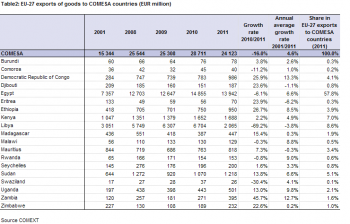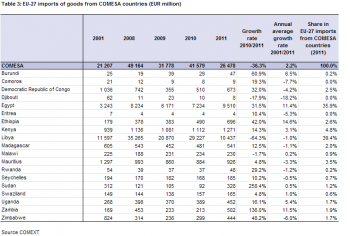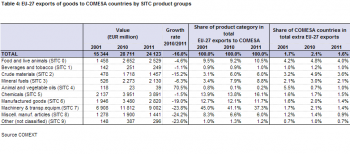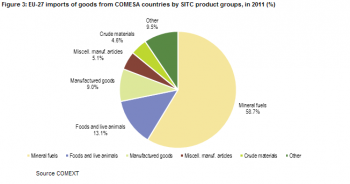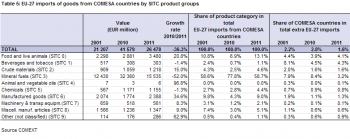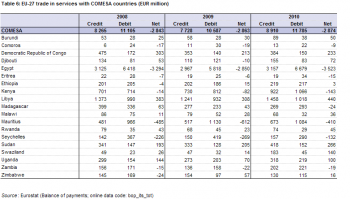Archive:EU trade with the Common Market for Eastern and Southern Africa (COMESA)
- Data from Month Year. Most recent data: Further Eurostat information, Main tables and Database.
Within Africa, COMESA, the Common Market for Eastern and Southern Africa, is an important trading partner of the EU-27, in particular for mineral fuels. In 2011, COMESA countries accounted for 18 % of EU-27 imports from Africa and 18 % of exports to Africa. The interruption of mineral fuel shipments from Libya during the uprising in that country in 2011 caused a sharp 36 % decline in EU-27 imports from the COMESA countries in 2011. At the same time, the world economic downturn and the impact of the Arab Spring on Egypt and the events in Libya led to a fall of 16 % in EU-27 exports to the group. Egypt is by far the largest market for EU-27 exports to COMESA, taking well over half of the total in 2011, even though it suffered a 6 % reduction compared to 2010. Machinery and transport equipment remained the largest EU-27 export category to the COMESA countries, making up 37 % of the total in 2011. Despite the impact of the events, Libya remained the largest source of EU-27 imports from COMESA, with 39 % of the total. Egypt was the second largest source with 36 % of the total. Mineral fuel was COMESA’s largest EU-27 import, despite the supply problems from Libya. It accounted for well over half the total in 2011. In 2010, Egypt was by far the country with the largest trade in services with the EU-27 in the COMESA group. Its large and thriving tourist industry created a net deficit for the EU-27 of EUR 3.5 billion in 2010. Three other major tourist destinations, Mauritius, Kenya and the Seychelles also produced a deficit for the EU-27 on service sector trade.
Main statistical findings
The Arab Spring and the Libyan uprising impact COMESA imports and exports to/from the EU-27 in 2011
In the decade since 2001, COMESA's population has grown dynamically with an annual average growth rate over 2 %, a very similar rate to Africa's as a whole. Throughout the period, COMESA accounted for a little over 43 % of total African population (Table 1).
Commercial exchanges between the EU-27 and COMESA went through important variation over the last decade.
Until 2010, the average annual growth rate in EU-27 exports to the COMESA countries was over 7 % while for Africa as a whole, it averaged 6.5 %. However, although the growth in EU-27 exports to the COMESA countries between 2009 and 2010 was around 13 %, this is lower than the figure of nearly 16 % for Africa as a whole.
Taking the figures for exports forward one year to 2011, table 2 shows the impact of the “Arab Spring” in terms of lower exports to Egypt and the even greater impact of the Libyan uprising, which substantially disrupted trade with that country. The outcome of these events was a reduction in Libya’s share of EU-27 exports falling from nearly a quarter in 2010 to under 9 % in 2011. At the same time, Egypt saw its share rise to nearly 60 % of COMESA's total, despite a drop of 6 % in EU-27 exports to that country. Of the other countries, Sudan and Kenya's share of total EU-27 exports to COMESA were each over 5%.
Another impact of the events in Libya and the “Arab Spring” in 2011 was a drop in the annual average growth rate of EU-27 exports to COMESA from over 7 % per annum in the period 2001 to 2010 to 4.6 % in the period 2001 to 2011 due to a negative growth rate of -16% for 2010-2011. Over the same period of 2001-2011, the Democratic Republic of Congo and Zambia both recorded annual growth rates in EU-27 exports of around 13 % with Uganda, Rwanda, Malawi and Ethiopia not far behind.
Political changes in Egypt and Libya had an even more marked impact on the import side of the trade balance. As Table 3 shows, EU-27 imports from COMESA countries have been very erratic in recent years. In 2008, they were valued at just under EUR 50 billion, before falling to EUR 32 billion in 2009. After a recovery to EUR 42 billion in 2010, they fell away again to EUR 26 billion in 2011. Much of this variation is explained by changes in imports from Libya, the EU-27’s major COMESA import partner. Oil imports from Egypt, COMESA’s second largest EU-27 import partner, rose markedly in 2011 and partly offset the fall in imports from Libya.
Imports from COMESA countries have grown at an annual average rate of 2 % between 2001and 2011. This compares with a growth rate of EU-27 imports of goods from COMESA of almost 8% from 2001-2010. Over the period to 2011, Ethiopia, Zambia and Egypt achieved import annual average growth rates of over 10 %. Kenya, the third largest COMESA import source at EUR 1.3 billion, had an average growth rate of 3 %. In contrast, over the same period, there were falls in imports from Zimbabwe (annual average 6 %), the Democratic Republic of Congo (4 %) and Mauritius (3 %).
Aside from Libya and Egypt, Kenya led a group of middle ranking import countries, which included Mauritius, Ethiopia, the Democratic Republic of Congo, Madagascar and Zambia, all with more than EUR 500 million of EU-27 imports in 2011. In contrast, the EU-27 imports from Eritrea, Djibouti and the Comoros amounted to just over EUR 20 million in the same year.
The Libyan uprising caused a major fall in EU-27 imports of mineral fuels from COMESA in 2011.
In their composition, EU-27 exports to the COMESA countries have remained relatively stable in recent years. Machinery and transport equipment accounted for 37 % of total EU-27 exports in 2011 (Fig 2), with the total including the delivery of some Airbus aircraft. Chemicals, including pharmaceuticals, at 16 %, was the next largest group, followed by manufactured goods at 12 %, food and live animals 10.5 %, mineral fuels 9 % and crude materials 6 %. Over the longer run, comparing 2001 with 2011 (Table 4), mineral fuels have more than doubled their share with Chemicals also rising. Machinery and transport equipment in contrast has seen its share decline.
Despite the 16 % fall in total exports from EU-27 to COMESA between 2010 and 2011, the composition in terms of products of these exports was similar in 2010 and 2011.
EU-27 exports to COMESA countries accounted for 1.6 % of total EU exports in 2011, less than the 2.1 % in 2010 and the 1.7 % in 2001. At the detailed product level, the COMESA countries accounted for 4 % of EU-27 exports of food, 3.5 % of crude material exports and 2 % of mineral fuel exports.
EU-27 imports from the COMESA countries in total fell sharply in 2011 compared to 2010, recording a 36 % decline from EUR 42 billion to EUR 26 billion (Table 5). The main factor influencing this change was the impact of the events in Libya which led to a fall in mineral fuel imports of 52 % between the same years. This decline was partly offset by increases in food and live animals (21 %), manufactured goods (35 %), crude materials (15 %) and miscellaneous manufactures (9 %).
In terms of the composition of EU-27 imports from COMESA (Figure 3), mineral fuels remained by far the largest single component, accounting for 59 % of the total but well down on its 78 % in the previous year and similar to the level of 2001. In contrast, the share of food and live animals rose from 7 % in 2010 to 13 % in 2011. The product group "Chemicals, including pharmaceuticals" saw its share rise in 2011, up to 4.4 %, compared to around 2.8 % in 2010 and 2001. Manufactured goods, including non-ferrous metals, increased as a share of the total to 9 % in 2011 from 4.3 % in 2010 approaching the level of 2001. Some of these evolutions can be explained by the changes in commodity prices, particularly oil and non-ferrous metals.
In 2011, COMESA countries supplied 1.6 % of total EU-27 imports, down from 2.8 % recorded in 2010 and 2.2 % in 2001. This fall was largely a reflection of the sharp decline in mineral fuel imports from COMESA. After accounting for around 8 % of total EU mineral fuel imports in 2001 and 2010, the figure declined to 3.2 % in 2011. COMESA also accounted for around 4 % of EU-27 food imports and beverage and tobacco imports each.
Tourism to Egypt generated a large EU-27 deficit on services with the COMESA countries in 2010
The EU-27’s trade in services with COMESA countries recorded a deficit of some EUR 3 billion in 2010, with debits of EUR 12 billion more than outweighed by credits of EUR 9 billion (Table 6). This pattern has been in place since 2008. Trade in services with Egypt dominates with a net deficit of EUR 3.5 billion, made up of debits of EUR 6.5 billion and credits of EUR 3 billion.
At a more detailed level, the deficit with Egypt reflects deficits on the travel and transportation accounts, partly offset by a surplus on other services. In 2010, these debits with Egypt came to EUR 5.5 billion, a large part of the EUR 6.5 billion COMESA total. This reflects the importance of Egypt as a major tourist destination. While similar detail on the composition of the service sector account is not available for the other countries, deficits, although not on the same scale as for Egypt, were recorded for all other important tourist destinations, Mauritius (EUR 410 million), Kenya (EUR 143 million) and the Seychelles (EUR 132 million).
In contrast to these deficits, in 2010, the EU-27 recorded surpluses with Libya (EUR 440 million), Sudan (EUR 266 million) and the Democratic Republic of Congo (EUR 233 million).
With some exceptions, these patterns of surplus or deficit have remained relatively consistent over the period since 2008, with little change in the net position at the total COMESA level or for individual countries.
Data sources and availability
This publication focuses on the COMESA, the Common Market for Eastern and Southern Africa.
Its Mission to “Endeavour to achieve sustainable economic and social progress in all Member States through increased co-operation and integration in all fields of development particularly in trade, customs and monetary affairs, transport, communication and information, technology, industry and energy, gender, agriculture, environment and natural resources”.
The 19 countries members of the COMESA are:
• Burundi
• Comoros
• Democratic Republic of Congo
• Djibouti
• Egypt
• Eritrea
• Ethiopia
• Kenya
• Libya
• Madagascar
• Malawi
• Mauritius
• Rwanda
• Seychelles
• Sudan
• Swaziland
• Uganda
• Zambia
• Zimbabwe
EU-27: European Union composed of 27 Member States: Belgium, Bulgaria, Czech Republic, Denmark, Germany, Estonia, Ireland, Greece, Spain, France, Italy, Cyprus, Latvia, Lithuania, Luxembourg, Hungary, Malta, Netherlands, Austria, Poland, Portugal, Romania, Slovenia, Slovakia, Finland, Sweden and United Kingdom.
Data sources:
The figures presented in this publication have been extracted from Eurostat’s free dissemination database and reflect the state of data availability in March 2012.
Data on the trade of goods are also available in Eurostat’s Comext database. In the methodology applied for the statistics on the trading of goods between Member States and non-member countries (extra-EU trade), statistics do not record exchanges involving goods in transit, placed in a customs warehouse or given temporary admission (for trade fairs, temporary exhibitions, tests, etc.). This is known as "special trade". So the partner will be the country of final destination of the goods.
Data on the trade of services are based on balance of payments statistics. The balance of payments records all economic transactions between a country (i.e. its residents) and foreign countries or international organisations (i.e. the non-residents of that country) during a given period. As part of the balance of payments, the current account records real resources and is subdivided into four basic components: goods, services, income and current transfers. The methodological framework used is that of the fifth edition of the International Monetary Fund Balance of Payments Manual (BPM5). The EU balance of payments is compiled by Eurostat in accordance with a methodology agreed with the European Central Bank (ECB).
SITC classification (Figures 2 and 3; Tables 3, 4 and 5) Information on commodities exported and imported is presented according to the SITC classification (Standard International Trade Classification) at a general level. A full description is available through Eurostat’s classification server RAMON, accessible through http://ec.europa.eu/eurostat/ramon/
COMEXT data (trade of goods) Please note that the sums of the individual SITC product categories are less than the totals due to confidentiality reasons.
In this publication:
1 billion = 1 000 million
: not available
Context
Within Africa, COMESA, the Common Market for Eastern and Southern Africa, is an important trading partner of the EU-27, in particular for mineral fuels. This article presents international trade between the European Union and COMESA countries.
Further Eurostat information
Main tables
- Balance of payments, see:
- Balance of payments - International transactions (t_bop)
- International trade in services, geographical breakdown (t_bop_its)
- External trade, see:
- External trade data (t_ext)
Database
- Balance of payments, see:
- Balance of payments - International transactions (bop)
- International trade in services, geographical breakdown (bop_its)
- External trade, see:
- External trade data (ext)
- External trade detailed data (detail)
Dedicated section
Methodology / Metadata
- Eurostat - RAMON (classification server)
- IMF Balance of Payments Manual - Fifth edition
- OECD Benchmark Definition of Foreign Direct Investment - Third edition
